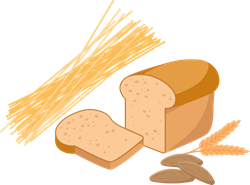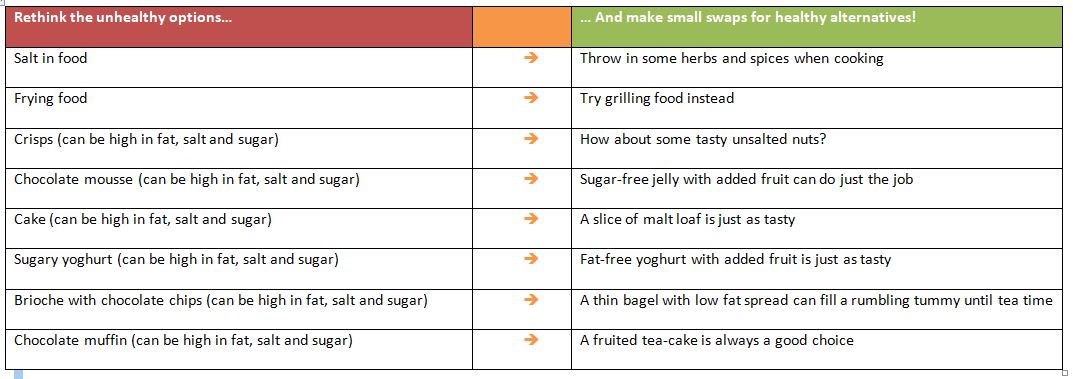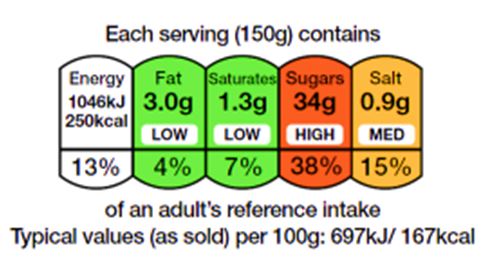Healthy Food and Drink
5 a day: Fruit and Vegetables
Choose from fresh, frozen, canned, dried or juiced.
A portion is 80g, or any of these examples:
- 1 apple, banana, pear, orange or other similar-size fruit,
- 3 heaped tablespoons of vegetables, a dessert bowl of salad,
- 30g of dried fruit (which should be kept to mealtimes) or
- 150ml glass of fruit juice or smoothie (counts as a maximum of one portion a day). Pure fruit juice should be kept to mealtimes as the natural sugars can still cause damage to your teeth. Whole fruit can be eaten at any time as a healthy snack.
NHS Information on 5 a Day
Click here for more information from the NHS on 5 a day.
Reheating Leftovers
Click here for more information on safely reheating leftovers.
Freezing Food
Click here for more information on safely freezing food you don’t want to eat yet.
Bulk Your Meals with Vegetables, Beans, and more
Click here for more information on how to bulk up your food with vegetables.
Chill, Freeze, and Defrost Food Safely
More information on chilling, freezing, and defrosting food safely.
The Carbs: Potatoes, Bread, Rice, Pasta, and Others
It is really important we have starchy foods as part of a healthy diet. Starchy foods should make up a third of the food we eat. As much as possible, choose higher-fibre, wholegrain varieties such as; whole-wheat pasta, brown rice or simply leave the skins on potatoes.Base your meals around starchy carbohydrate foods, take a look at the meal ideas below:
Breakfast: start the day right with a wholegrain breakfast cereal (choose one lower in salt and sugars)
Lunch: have a sandwich for lunch (brown bread or wholegrain bread)
Tea/Dinner: round off the day with potatoes, pasta or rice as a base for your evening meal
Tameside Top Tips:
- Choose wholegrain or higher fibre foods in this food group with less added fat, salt and sugar. Wholegrain food contains more fibre than white or refined starchy food and often has more nutrients than others.
- Eating wholegrain foods makes us feel fuller for longer (this can prevent us snacking on high fat, salt and sugary snacks if we get a bit peckish in-between meals)
 Which foods are wholegrain foods?
Which foods are wholegrain foods?
Wholemeal and wholegrain bread, pitta and chapatti, whole-wheat pasta, brown rice, wholegrain breakfast cereals and whole oats. Remember, you can also purchase high fibre white versions of bread and pasta which will help to increase your fibre intake using a like-for-like substitute of your family favourites.Cooking Meals with Wholegrains
More information on cooking meals with wholegrains.
Dairy and Alternatives
Milk and dairy food (or dairy alternatives) such as cheese, yoghurt and fromage frais helps us to get good sources of protein and vitamins. These are a great source of calcium which help to keep our bones strong. Some dairy food can be high in fat and saturated fat but don’t worry there are lots of lower-fat options to choose from.Tameside Top Tips:
Go for lower fat and lower sugar products where possible e.g. try 1% fat milk which contains about half the fat of semi-skimmed milk without a noticeable change in taste and texture.
- You could also go for lower/reduced fat in cheese and yogurts too. Natural yoghurts are tasty on their own or even better with added fruit. This is a much healthier option than many yoghurts which can contain high levels of sugar.
- Try having have a smaller amount of full-fat varieties less often
- When buying dairy alternatives go for unsweetened, calcium-fortified versions
NHS Information on Dairy
Click here for more information on milk and dairy from the NHS.
Beans, Pulses, Fish, Eggs, Meat, and Other Proteins
These types of foods are good sources of protein, vitamins and minerals so it is important to eat some foods from this group.
If you are looking for alternatives to meat then beans, peas and lentils (all types of pulses) are good alternatives to meat and are naturally very low in fat, high in fibre, protein, vitamins minerals.
Aim for at least 2 portions (2x140g) of fish a week, including a portion of oily fish. Most people should eat more fish, but there are recommended limits for oily fish, crab and some types of white fish. For more information on fish, click here: https://www.nhs.uk/live-well/eat-well/fish-and-shellfish-nutrition/ For information on sustainably sourced fish, click here: https://www.msc.org/what-you-can-do/eat-sustainable-seafood/fish-to-eat
Some types of meat are high in fat, particularly saturated fat. When you are buying meat remember the type of meat or cut of meat you choose and how you cut it can make a big difference. For more information about having meat in your food, click here: https://www.nhs.uk/live-well/eat-well/meat-nutrition/
Eggs are tasty and good for you, poached or boiled eggs are a great alternative to a fried egg. For more information about healthy ways to eat eggs, click here: https://www.nhs.uk/live-well/eat-well/eggs-nutrition/
Tameside Top Tips:
Aim to eat a portion of oily fish a week
- Remember the type of meat, cut and how you cook may provide different nutrients
- Choose lean cuts of meat or leaner mince meat
- Cut off the fat from meat and the skin from chicken
- Try to grill meat instead of frying
- Have a boiled or poached egg instead of a fried egg
- Aim to have no more than 70g of processed meat per day (processed meats include sausages, bacon, cured meats and reformed meat products)
- Choose sustainable fish if possible- find out more about sustainable fish here: https://www.mcsuk.org/goodfishguide/search
- Consider reducing your meat intake to reduce your carbon footprint. How about experimenting with meat alternatives.
- Take a look at the British Heart Foundation’s website for more information on portion guides for eating beans, pulses, fish, eggs, meat and other proteins:
Oils and Spreads
Some fat in the diet is essential but generally we are eating too much saturated fat and need to reduce our consumption.Unsaturated fats are healthier fats that are usually from plant sources and in liquid form as oil e.g. vegetable oil, rapeseed oil and olive oil. There are health benefits to swapping to unsaturated fats such as reducing cholesterol.
Tameside Top Tips:
- Choosing lower fat spreads instead of butter is a good way to reduce your saturated fat intake
Food and Drinks High in Fat, Salt, and Sugar
Chocolate, cakes, biscuits, full-sugar soft drinks, butter and ice cream are all foods high in fat, salt and sugars. These types of foods are not needed in our diet so if consumed, have them in small amounts and less often. If you consume these types of foods and drinks often how about an easy challenge for yourself and your family, have a go at limiting how often you have them and try to have smaller amounts and try to record your changes to see how far you’ve come.Food and drinks high in fat, salt and sugar have lots of energy in them which can be bad for our waistline and teeth and can cause many other health problems like becoming overweight, obesity, high blood pressure and tooth decay amongst others
Tameside Top Tips:
If you’re feeling you need a little something to satisfy your sweet tooth instead of reaching for a slice of cake, or try some fresh fruit a slice of malt loaf
- Kick start the day by kicking out those sugary cereals and give yourself an energy boost by throwing together some porridge or Weetabix and add some fruit
Try the Tameside Swap Challenge by having a look at the swap suggestions below and see if you can have a go!

NHS Guide on Salt and Sugar
Click here for more information on keeping your salt and sugar intake to a minimum.
Sugar Calculator
Click here to find out how much sugar is in everyday food and drinks you may have.
Most of us are eating more salt than we realise, take a look at the maximum daily amounts of salt each age group should have as a maximum:
NHS Reduce Salt and Sugar Intake
For more information on how to reduce your salt and sugar intake.
Perfect Portion Sizes
We often eat more than we need and portion sizes can be something we learn or are influenced by from those who we live with or where we eat, what and how much we eat can be based on generational or cultural norms. Having various sized plates and bowls can make portion control even harder to understand.Tameside Top Tips:
- Your plate doesn’t need filling completely /use a smaller plate so a healthy portion fills it up
- If your portion sizes are too big, your weight and your blood glucose control will be harder to keep an eye on. Get to grip with portion sizes by taking a look below
- Weight-loss can stop or slow down if your portion sizes are too big
Handmade portion sizes by you.
You can use your hands as an easy-peasy way to measure your food portions, take a look at the hands below and have a go for yourself…Take a look at the portion guide below which shows how much of each type of food you should be having.
Red, Amber, Green! Understanding the traffic lights and food labelling
Lots of pre-packaged food have food labels on them (usually on the front of the package), which tells you the nutrition information per serving. The food label should also tell us how much of each nutrient should be included in the daily diet. The food label will also show percentages which tell us the contribution the produce makes our daily diet.Food labels are handy as they can help you choose between foods and drinks which are lower in energy, fat, saturated fat, sugar and salt. Some food labels are colour coded which makes it really easy for us to know if they are high, medium or low in fat, saturated fat, sugars and salt.

Tameside Top Tips:
- A healthier choice, try to pick foods or drinks with more green and ambers and fewer reds
- Green labels are a go!
- Portion sizes displayed on the food labels are just suggestions – check how many suggested portions are in the whole pack
- Some foods and drinks consumed as single servings from pre-packaged products have the nutritional information presented as half of the pack (you would really be eating double the amount you should be)
- Cooking from scratch means you know exactly what is in your meal
Stay Hydrated With H20: Hydration
We should aim to drinks 6-8 glasses of fluid every day. Water, lower fat milk and sugar-free drinks including tea and coffee can all help you towards achieving your 6-8 glasses per day. Fruit juice and smoothies count towards your fluid consumption, however they are a source of free sugars, so should you should limit your consumption to no more than a combined total of 150ml per day.Alcohol contains lots of calories (kcal) and should be limited to no more than 14 d the amount of mixer you have with it e.g. lemonade. 1 pint of standard strength larger contains approximately 136 calories, a 175ml medium glass of wine contains approximately 135 calories and a 25ml shot of spirit (40% vol) contains approximately 56 calories.
Tameside Top Tips:
- Simply swap sugary soft/fizzy drinks for sugar-free or no added sugar varieties to reduce your sugar intake
- Carry a refillable water bottle with you to keep hydrated on the go. There are over 40 refill stations across Tameside, meaning you can refill your water bottle for free there. For more information on keeping hydrated and reducing single-use plastics click here
- A beer or glass of wine doesn’t just affect your wallet; it can affect your waistline too with the hidden calories.
Tameside Refill Scheme
Click here to find out where you can refill your water bottle for free in Tameside.

